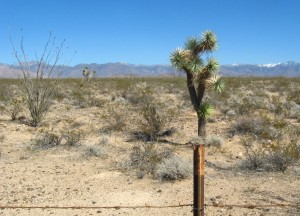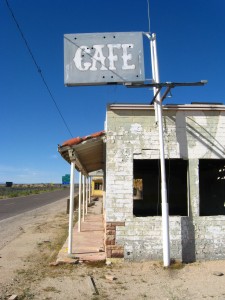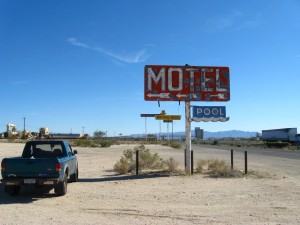
http://lyndsaycambridge.com/tag/young-adult The Joshua Tree
Sirsāganj Along I-40 I had to pull off to the side of the road to get a glimpse of a plant. I was fairly sure it was Yucca brevifolia, a Joshua Tree. It is a signature plant of the Mojave Desert, and is as far as I know naturally absent from the Sonoran Desert area around Tucson. It was the first I had seen.
I was not the first person to notice how unusual the Joshua tree is in central Arizona. The next town was called “Yucca.”
There is some natural reason for enthusiasm about this plant – its treelike stature is so unusual in this landscape – and its form is so unpredictable, being contorted and only rarely linear – and in the desert anything as large as a tree must always stand alone. But I cannot deny that the place it has in my mind is largely because of the U2 album, and its sequel Rattle and Hum, which provided a host of sounds and images and thoughts to my teenage mind. The music is by now so wedded in my mind to this landscape that I cannot pass through it without thinking certain musical thoughts. In particular I hear “One Tree Hill,” “Heartland,” “All I Want Is You,” and “In God’s Country.” I don’t have a CD or tape player in my car, but I know the music well and can replay it in my mind as I drive. “One Tree Hill” also quickly brings my mind to “Unchained Melody” –
Lonely rivers flow
To the sea, to the sea
To the open arms of the sea
Lonely rivers sigh
Wait for me, wait for me
I’ll be coming home
Wait for me.
“We run like a river runs to the sea.”
U2 was following a pattern already established by rock musicians from the British Isles (if they will forgive the term), who generally produced their best music when they attempted to artistically assimilate as much as they could of America. To me it is endlessly fascinating. The excellent Wikipedia article on the Joshua Tree album – my goodness, Wikipedia just keeps getting better in time – describes what seems to me to be a completely advisable artistic process:
Inspired by American tour experiences, literature, and politics, U2 chose America as a theme for the record…. Several events during the sessions helped shape the conscious tone of the album, including the band’s participation in A Conspiracy of Hope tour, the death of roadie Greg Carroll, and lead vocalist Bono‘s travels to Central America…. Throughout the sessions, U2 sought a “cinematic” quality for the record that would evoke a sense of location, in particular, the open spaces of America. They represented this in the sleeve photography depicting them in American desert landscapes….
Thematically, the album juxtaposes antipathy towards the United States against the band’s deep fascination with the country, its open spaces, freedoms, and ideals. Anger is directed particularly at the perceived greed of the Ronald Reagan administration and its foreign policy in Central America.[45] Bono said, “I started to see two Americas, the mythic America and the real America”,[46] hence the album’s working title, The Two Americas.[1]
Another working title was Desert Songs. These are fabulous working titles and express immediately why the album is still so fascinating. “In the long run men hit only what they aim at. Therefore – they had better aim at something high.” Even though many of the tracks do not excite me, and much of the production I feel could be improved, the greatness of the theme gives worth to the whole endeavor.
Settling on the title The Joshua Tree was inspired:
The album sleeve was designed by Steve Averill,[30] based on the band’s idea to depict the record’s “imagery, and cinematic location” in the desert. The initial concept for the sleeve was to represent where the desert met civilisation,[1] and accordingly, one of the provisional titles for the album was The Desert Songs.[57] They asked their photographer Anton Corbijn to search for locations in the United States that would capture this.[21] From 14–16 December 1986, the band travelled with Corbijn and Averill on a bus around the Mojave Desert in California for a three-day photo shoot. The group stayed in small hotels and shot in the desert landscape, beginning at the ghost town of Bodie before moving to locations such as Zabriskie Point and other sites in Death Valley.[19] For the shoot, Corbijn rented a panoramic camera to capture more of the desert landscapes, but having no prior experience with the camera, he was unfamiliar with how to focus it. This led to him focusing on the background and leaving the band slightly out of focus. Corbijn said, “Fortunately there was a lot of light.”[18]
… On the evening after the first day’s shooting, Corbijn told the band about Joshua trees (Yucca brevifolia), hardy and twisted plants in the deserts of the American Southwest, and he suggested their use on the sleeve.[1] Bono was pleased to discover the religious significance of the plant’s etymology;[57] early settlers, according to Mormon legend, named the plant after the Old Testament prophet Joshua, as the tree’s stretching branches reminded them of Joshua raising his hands in prayer. The following day, Bono declared that the album should be titled The Joshua Tree.[57] That day, while driving on Route 190, they spotted a lone-standing tree in the desert, unusual since the plant is usually found in groups.[1] Corbijn had been hoping to find a single tree, as he thought it would result in better photographs than if he shot the band amongst a group of trees.[57] They stopped the bus and photographed with the lone plant for about 20 minutes, something The Edge called “fairly spontaneous”.[45] Despite shooting in the desert, the group dealt with cold weather. Bono explained, “it was freezing and we had to take our coats off so it would at least look like a desert. That’s one of the reasons we look so grim.”[59]
Joshua in prayer is an image of precisely the idea embodied in The Two Americas – the contrast between desire and attainment of the Promised Land – and Joshua as a historical figure functions just as well, because the actual taking of the Promised Land – the rape of Canaan – contains in itself all the horror that makes attainment failure.
I-40 roars right through the heart of Yucca. The businesses which catered to travelers along the old Main Street – which was Route 66 – are now all closed. I spend a half hour walking around town, where I see no one but snap a few photos while the semis whoosh by.


Post a Comment